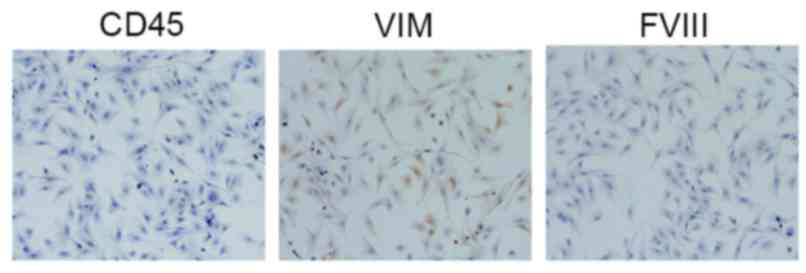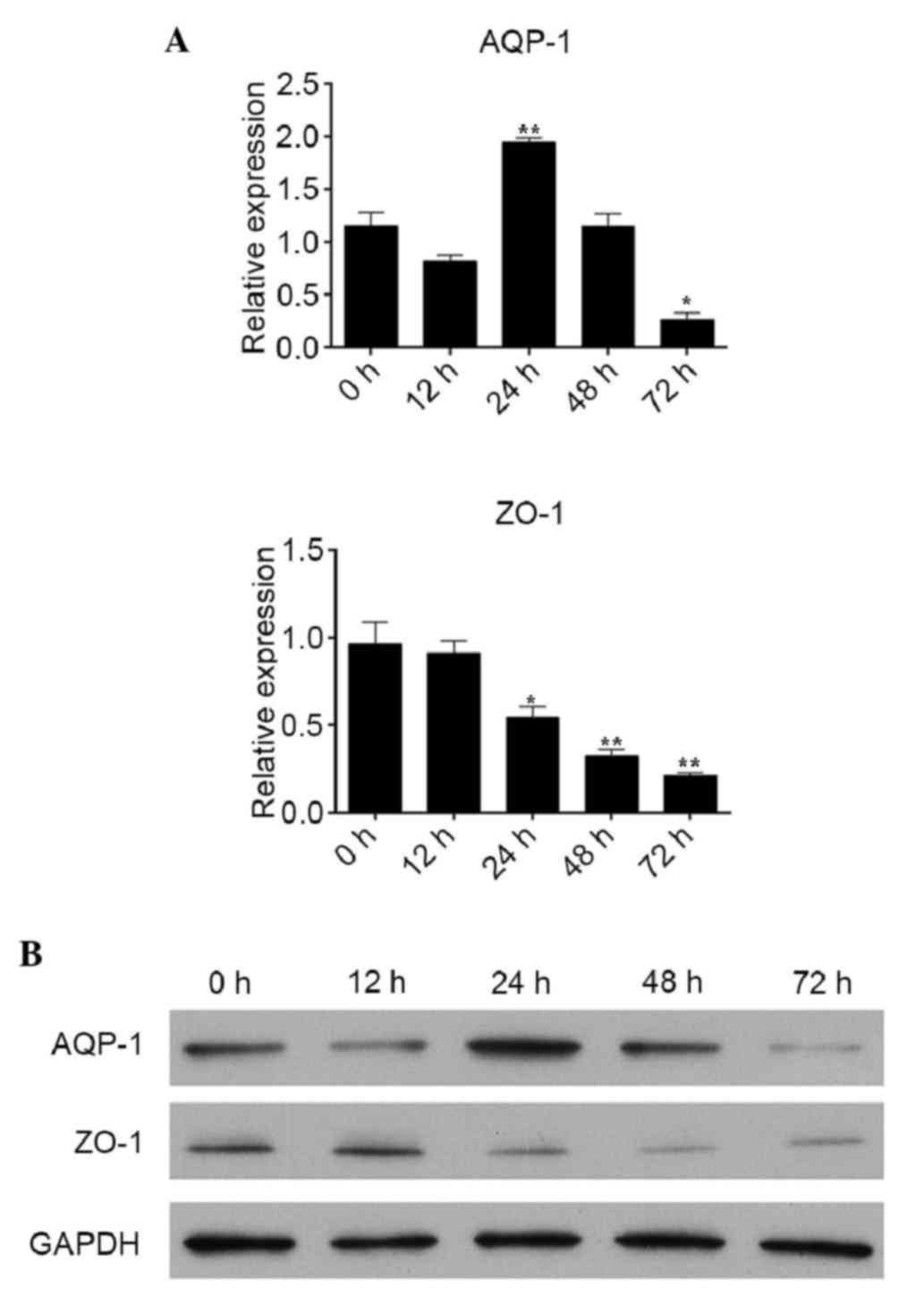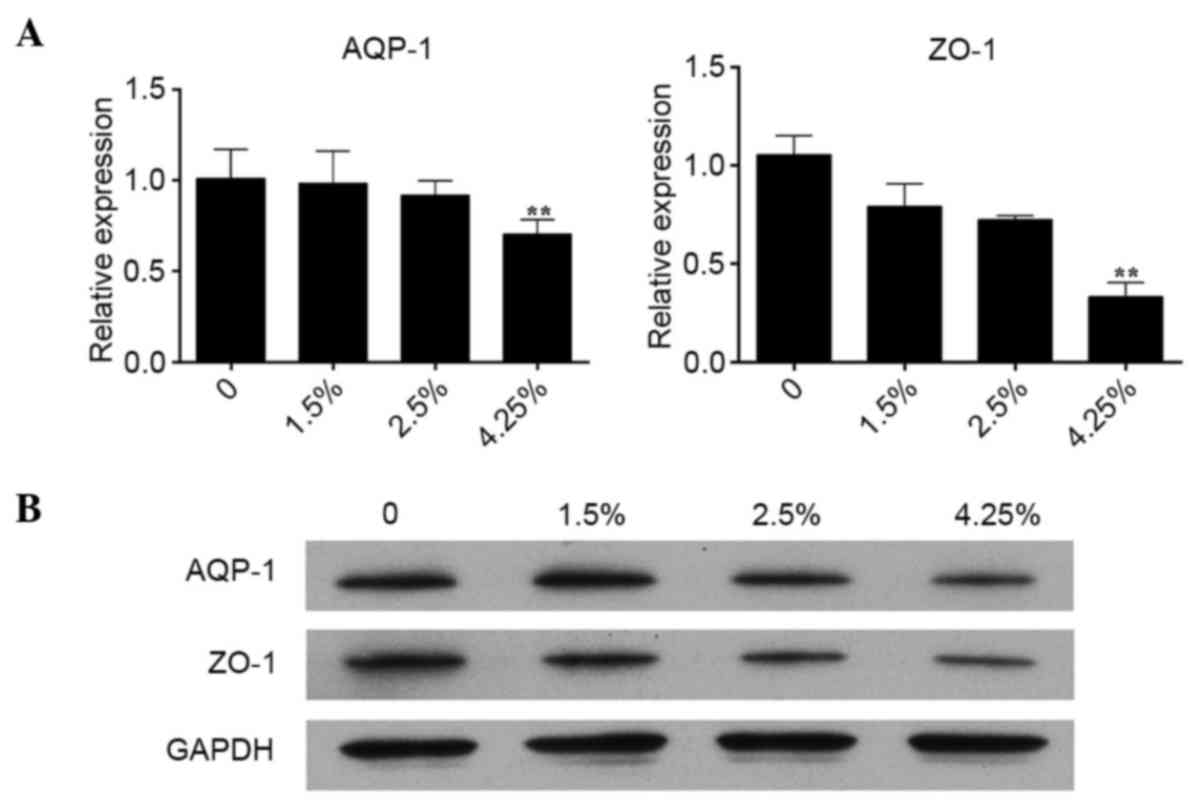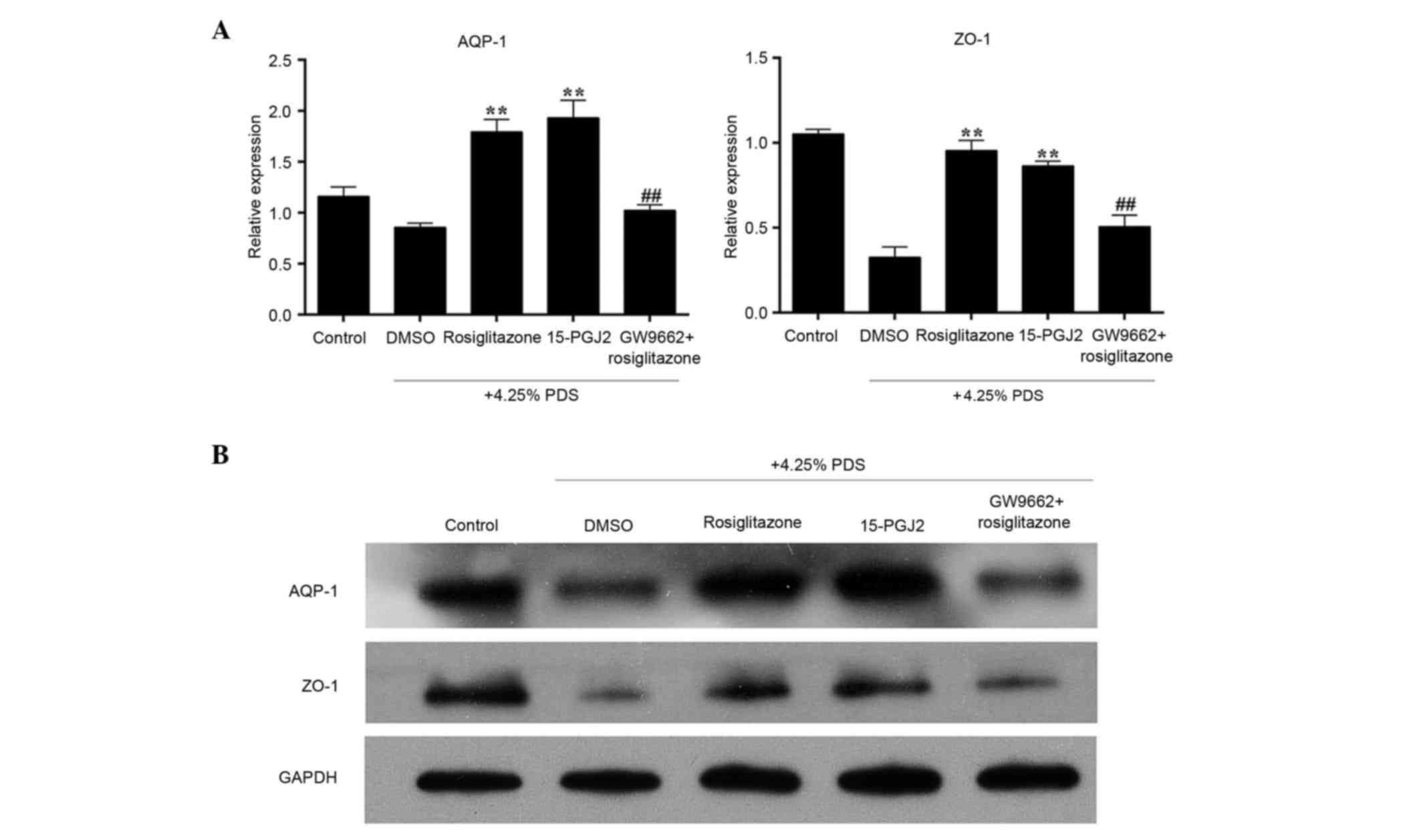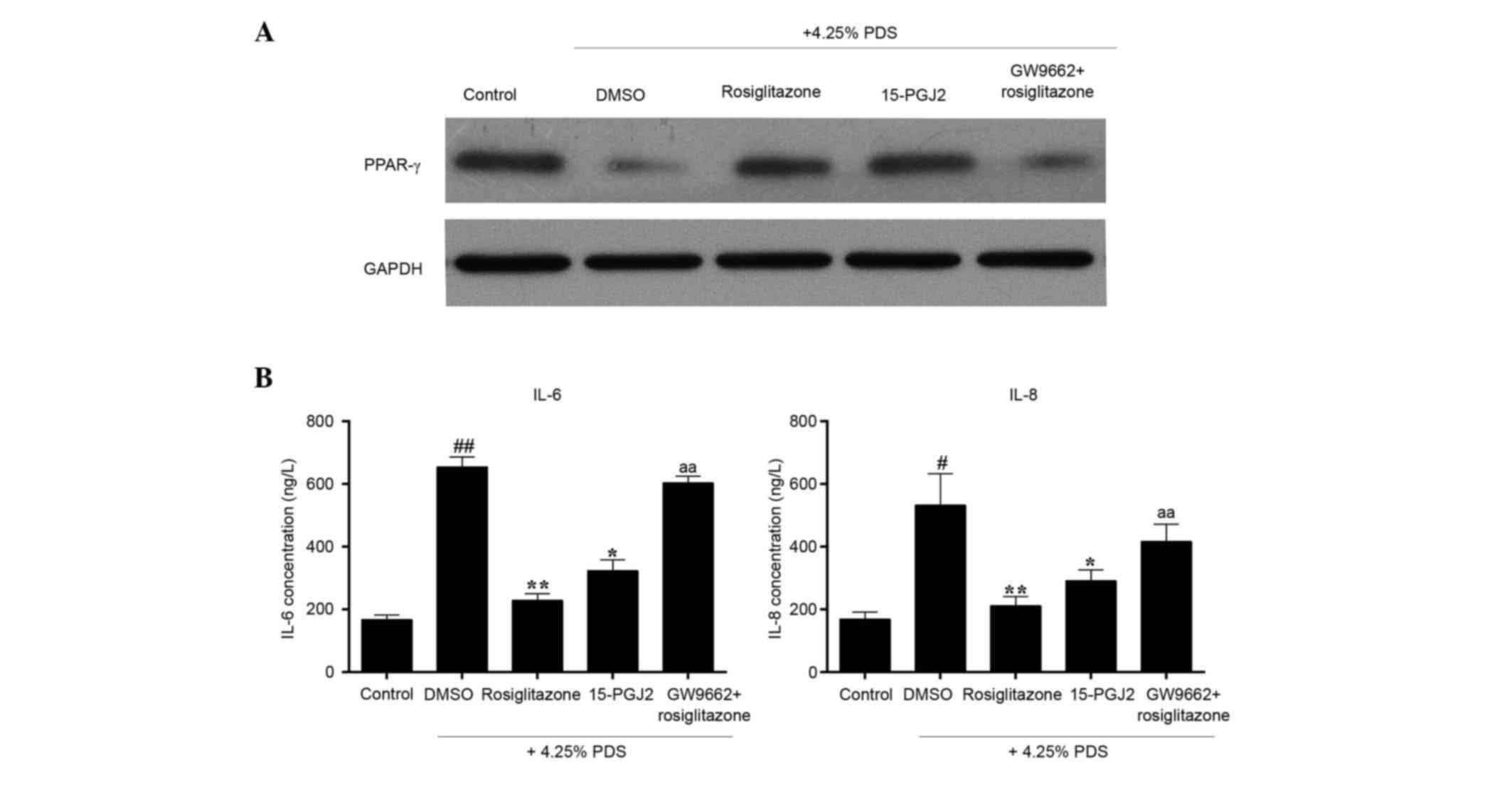PPAR‑γ agonist rosiglitazone protects rat peritoneal mesothelial cells against peritoneal dialysis solution‑induced damage
- Authors:
- Published online on: February 13, 2017 https://doi.org/10.3892/mmr.2017.6196
- Pages: 1786-1792
Abstract
Introduction
Peritoneal dialysis (PD) is an efficient kidney replacement therapy for patients with end-stage renal failure (ESRF). Its lower infection rates and reduced costs significantly improve quality of life and increase the survival rates of patients (1). However, the peritoneal membrane, which is directly and continuously exposed to the peritoneal dialysis solution (PDS) exhibits structural and functional alterations following long-term exposure to PD, and causes a decline in peritoneal ultrafiltration capacity, eventually resulting in ultrafiltration failure (UFF) (2). The potential factors responsible for UFF are complex, predominantly including the peritonitis caused by repeated microbial infection and the chronic aseptic inflammation caused by non-physiological dialysis fluid (3). The physiological morphology of the peritoneum eventually evolves showing loss of the mesothelial cells layer, abnormal proliferation of connective tissue, angiogenesis, obliterating vasculopathy, submesothelial fibrosis and calcification, resulting in dysfunction of the exchange between the blood and dialysate (4). Peritoneal mesothelial cells (PMCs) are the most important cell populations of the peritoneum, and are critical in the maintenance of peritoneal homeostasis, immune surveillance, antigen presentation, inflammation and wound healing, regulating the structure and function of the peritoneum (5).
The expression of aquaporin-1 (AQP-1) and zonula occluden-1 (ZO-1) on the PMCs modulates ultrafiltration during PD through different mechanisms, and are important indicators for the evaluation of peritoneal ultrafiltration function (6,7). As water constitutes the most important component of all viable cells, water uptake and discharge are two of the most basic activities in life. It has been reported that there are two ways for water to cross the cell membrane; one being through diffusion, which is affected by temperature, and the other being via the water-selective AQP-1 channel (6). The water transport mediated by AQP-1 accounts for ~90% of the overall ultrafiltration (8). ZO-1-associated tight junction formation is considered to be important for maintaining the osmotic pressure gradient between the peritoneal capillaries and the dialysate (7). Therefore, abnormal expression of AQP-1 and ZO-1 leads to degenerated function of the peritoneum.
Peroxisome proliferator-activated receptor-γ (PPAR-γ) is a member of a nuclear hormone receptor family, which regulates various metabolic pathways as a transcription factor. It is crucial in the regulation of cellular inflammation, fibrosis and endothelial function (9). Thiazolidinedione, similar to rosiglitazone is a selective PPAR-γ activator, which is used extensively in the treatment of type 2 diabetes mellitus (10). Previous reports have demonstrated that pretreatment with rosiglitazone results in decreased inflammation and peritoneal thickness in a lipopolysaccharide-induced peritonitis rat model (11). Aramwit et al (12) found that, in patients receiving continuous ambulatory peritoneal dialysis who were administered with rosiglitazone (2 mg BID) for 12 weeks, the total body water and extracellular fluid increased significantly (12).
The present study was designed to investigate the potential protective effects of the PPAR-γ agonist, rosiglitazone, on the peritoneal alterations in a PDS-induced RPMC model.
Materials and methods
Materials
Dulbecco's modified Eagle's medium (DMEM)/nutrient mixture F12 (1:1; DMEM/F12) medium and fetal bovine serum (FBS) were obtained from Invitrogen; Thermo Fisher Scientific, Inc. (Waltham, MA, USA). PDS (1.5, 2.5 and 4.25%) were from Baxter Healthcare Co., Ltd. (Shanghai, China). Rosiglitazone was from Molekula GmbH (Nienburg/Weser, Germany), and 15d-PGJ2 and GW-9662 were purchased from Cayman Chemical Company (Ann Arbor, MI, USA). Monoclonal antibodies against Vimentin (Vim), CD45, GAPDH and AQP-1 were from Abcam (Cambridge, UK). Monoclonal antibody against Factor VIII was from Bioss, Inc. (Woburn, MA, USA). Monoclonal antibodies against ZO-1 and PPAR-γ, and secondary horseradish peroxidase (HRP)-conjugated antibodies were from Santa Cruz Biotechnology, Inc. (Santa Cruz, CA, USA).
RPMC isolation and culture
The RPMCs were isolated and cultured, as described previously (13). Briefly, male Sprague-Dawley rats (150–250 g) were purchased from the Animal Experimental Center of Sun Yat-Sen University, (Guangzhou, China). The rats (n=40) were housed in plastic cages on bedding of chips. All rats were given the distilled water to drink and allowed free access to the water and pellet food. All rats were maintained at 25°C with 12-h light/12-h dark cycle. The mice were sacrificed with pentobarbital natrium (30 mg/kg at day 7 after surgery. All procedures were followed the rules of the Southern Medical University (Guangzhou, China) Animal Experiment Committee. Individual rats were injected intraperitoneally with 30 ml of 0.25% trypsinase-0.02% EDTA-Na2, and 5 ml abdominal fluid of individual rats was collected 2 h later, which was centrifuged at 820 × g for 10 min. The cells were washed in PBS and suspended in DMEM/F12 medium with 10% (v/v) FBS, and were then cultured in 25 cm2 tissue culture flasks at 37°C in a humidified 5% CO2 atmosphere. The cells were passaged every 3–5 days, and RPMCs from the second and third passages at 80% confluence were used for the following experiments.
Immunocytochemical staining
RPMCs at a density of 2×105/well were cultured overnight on glass cover-slips in 3.5 cm-diameter tissue culture plates. For immunostaining for DAPK-and RASSF1A, antigen retrieval was performed using microwaves for 10 min. The slides were exposed to Power Block (BioGenex Laboratories, San Ramon, CA, USA) for 45 min. The cells were fixed in cold 4% paraformaldehyde overnight, permeabilized with 0.5% Triton X-100 and then blocked with 5% normal goat serum (BioGenex Laboratories). The cells were then incubated with the following primary antibodies: Anti-Vim (1:150; cat. no. MMS-464S), anti-CD45 (1:150; cat. no. PB9096) and anti-Factor VIII (1:150; cat. no. PRO-318) in 1% BSA at 4°C overnight. Following washing three times in PBS, the slips were incubated with HRP-conjugated secondary antibodies for 2 h at 37°C. The reaction was terminated with 3,3-diaminobenzidine. Images of the results were captured (magnification, ×400) using a Nikon ECLIPSE 80i microscope (Nikon, Tokyo, Japan). The optical densities and numbers of DAPK- and RASSF1A-positive cells were counted in five randomly selected fields per sample in spinal anterior horn, and quantification was performed using Image-Pro Plus version 6.0 (Media Cybernetics, Inc., Rockville, MD, USA). Histology and immunohistochemistry for each marker were performed simultaneously in all samples and in negative controls without primary antibodies.
Western blot analysis
Western blot analysis was performed according to standard western blot procedures as previously described (9). The proteins were extracted using Pro-Pprep protein extraction solution (Intron Biotechnology, Inc., Seongnam, South Korea) from the frozen kidney tissues. The protein concentration was measured using Dc Protein Assay kit (Bio-Rad Laboratories, Hercules, CA, USA). Proteins (30 g per lane) were separated by 10% SDS-PAGE and then transferred onto nitrocellulose membranes (Bio-Rad Laboratories, Inc., Hercules, CA, USA). Following blocking in 5% nonfat milk, the membranes were incubated with the following primary antibodies: AQP-1 (1:300; cat. no. sc-32739), ZO-1 (1:300; cat. no. 33-9100), PPAR-γ (1:300; cat. no. sc-7273) and GAPDH (1:1,000; cat. no. E12-052-1) overnight at 4°C, followed by incubation with the anti-rabbit HRP-conjugated secondary antibodies (cat. no. 1721011; Bio-Rad Laboratories) for 1 h at room temperature. Chemiluminescence was detected using ECL Advance Western Blotting Detection reagents (GE Healthcare Life Sciences, Chalfont, UK). The relative expression levels of AQP-1 and ZO-1 were quantified using ImageJ version 1.45.
Reverse transcription-quantitative polymerase chain reaction (RT-qPCR) analysis
Total RNA was extracted using TRIzol reagent (Ambion; Thermo Fisher Scientific, Inc.) according to manufacturer's protocols. The cDNAs used to examine the expression of AQP-1 and ZO-1 were synthesized using a PrimeScript RT reagent kit (Takara Bio, Inc., Otsu, Japan) according to manufacturer's protocols. The expression of AQP-1 and ZO-1 were examined using SYBR® Premix Ex Taq II (Takara Bio, Inc.), and GAPDH served as an internal reference. PCR was performed using 1 µl cDNA in a total volume of 25 µl in the presence of 12.5 µl 2xiQ Supermix (Bio-Rad Laboratories), 200 nM AQP-1, or ZO-1 primer set. PCR conditions were as follows: 40 cycles at 95°C for 30 sec, 60°C for 1 min using iCycler iQ qPCR detection system (Bio-Rad Laboratories). All experiments were performed in duplicate and repeated twice. The results are presented as the fold induction, determined using the 2−ΔΔCq method (14). The primers for AQP-1 were: Sense 5′-GCACAATGGGCTCTATCTTC-3′ and antisense 5′-GACAGTCGTTC-TATGGTGGG−3′. The primers for ZO-1 were: Sense 5′-AAAAGTGAACCACGAG-ATGCT-3′ and antisense 5′-AAAGGTAAGGGACTGGAGATGA-3′. The primers for β-actin were: Sense 5′-GGCAAGTTCAATGGCACAGT-3′ and antisense 5′-AAGGTGGAGGAATGGGAGTT-3′.
ELISA
With the collected cell culture supernatant, the concentrations of IL-6 and IL-8 were determined using commercial ELISA kits (R&D Systems, Inc., Minneapolis, MN, USA) according to the manufacturer's protocol. Three independent assessments were performed.
Statistical analysis
The results of the analyses are expressed as the mean ± standard deviation. Statistical analaysis was performed using Statview version 5.0 (SAS Intelligence, Cary, NC, USA) Statistically significant differences between groups were identified using one-way analysis of variance, followed by Student's t-test (paired). P<0.05 was considered to indicate a statistically significant difference.
Results
Identification of RPMCs
The identification of the cultured cells as RPMCs was based on their typical markers, CD45, Vim, Desmin and Factor VIII. Immunocytochemical staining of the cultured cells was performed, and the cells were then examined under an optical microscope. Of the characterized markers, it was found that the cells were positively stained for CD45 and Vim, and negatively stained for Desmin and Factor VIII (Fig. 1).
mRNA and protein levels of AQP-1 and ZO-1 in RPMCs treated with 4.25% PDS for different durations
To observe the effects of PDS on the levels of AQP-1 and ZO-1 in the RPMCs, the RPMCs were cultured with 4.25% PDS for 0, 12, 24, 48 and 72 h. Compared with the expression at 0 h, the gene expression of AQP-1 was significantly increased at 24 h, however, a decreasing trend was observed at 48 and 72 h, and this decrease was statistically significantly at 72 h. The mRNA levels of ZO-1 were significantly reduced 24, 48 and 72 h following treatment with 4.25% PDS, compared with the level at 0 h (Fig. 2A). As shown in Fig. 2B, compared with the levels at 0 h, the protein levels of AQP-1 were significantly decreased at 72 h, and the protein expression levels of ZO-1 were significantly decreased at 24, 48 and 72 h.
mRNA and protein levels of AQP-1 and ZO-1 in RPMCs treated with different concentrations of PDS for 72 h
To evaluate the effect of PDS on the levels of AQP-1 and ZO-1 levels in RPMCs, the RPMCs were cultured with different PDS concentrations of 0, 1.5, 2.5 and 4.25% for 72 h. Compared with the controls (PDS 0%), the gene expression levels of AQP-1 and ZO-1 showed a decreased trend, and these decreases were statistically significantly in the 4.25% group (Fig. 3A). Consistent with the results of the RT-qPCR analysis, the protein expression levels of AQP-1 and ZO-1 were significantly reduced in the 4.25% group, as demonstrated by the results of the western blot analysis (Fig. 3B).
Effects of rosiglitazone on the mRNA and protein expression of 4.25% PDS-induced AQP-1 and ZO-1
To evaluate the effect of rosiglitazone in the PDS-induced RPMC model, the RPMCs were pre-treated with 15 µmol/l rosiglitazone or with 5 µmol/l 15-PGJ2, another PPAR-γ agonist, for 2 h, or were pre-treated with 15 µmol/l rosiglitazone for 2 h following pre-treatment with 3 µmol/l GW9662, a PPAR-γ inhibitor, for 1 h. As shown in Fig. 4A, the gene expression levels of AQP-1 and ZO-1 in the 4.25% PDS-induced RPMCs were significantly enhanced by the PPAR-γ agoinst, rosiglitazone, compared the with model group (DMSO+4.25% PDS). The effects of the other PPAR-γ activator, 15-PGJ2, were consistent with that of rosiglitazone. By contrast, the mRNA levels of AQP-1 and ZO-1 in the RPMCs pre-treated with rosiglitazone and the PPAR-γ inhibitor were reduced significantly, compared with the RPMCs pre-treated with rosiglitazone only. As shown in Fig. 4B, further examination using western blot analysis revealed that the protein levels of AQP-1 and ZO-1 were significantly increased in the rosiglitazone group and 15-PGJ2 group, compared with the model group. The use of GW-9662 appeared to completely prevent the effects of rosiglitazone.
Effects of rosiglitazone on the protein levels of PPAR-γ and the secretion of IL-6 and IL-8
Previous studies have suggested that PPAR-γ is a target of rosiglitazone. In the present study, it was found that rosiglitazone was important in the injury induced by PDS in the RPMCs. The present study then investigated whether PPAR-γ is involved in the PDS-induced RPMC model. As shown in Fig. 5A, compared with the control group, the protein levels of PPAR-γ were reduced by 4.25% PDS. The expression of PPAR-γ was significantly elevated in the rosiglitazone group and the 15-PGJ2 group, compared with the model group (DMSO+4.25% PDS). The use of GW-9662 did not completely prevent the effects of rosiglitazone. The present study further investigated whether rosiglitazone has effects on the 4.25% PDS-induced secretion of the IL-6 and IL-8 inflammatory cytokines in the RPMCs. As shown in Fig. 5B, the levels of IL-6 and IL-8 in the cellular supernatant of the model group were significantly increased, compared with those in the control group. However, pre-treatment of the cells with rosiglitazone or 15-PGJ2 reduced these two inflammatory cytokines, compared with the model group. Compared with the rosiglitazone group, the decreases in the levels of IL-6 and IL-8 induced by rosiglitazone were reversed by GW-9662.
Discussion
PD is an important treatment modality for patients with ESRF, however, a decrease in ultrafiltration function and UFF are common complications in patients receiving long-term PD, and are a leading cause of PD dropout (4). The impaired ultrafiltration leads to the retention of body water and sodium, increases the risk of cardiovascular disease and results in poor prognosis, particularly in patients with loss of residual renal function (15).
AQPs are a group of water-selective channel proteins. They are important in maintaining fluid balance in an organism. Until now, 14 isoforms have been identified. AQP-l was the first member to be identified in this family (16). AQP-l has been reported to be responsible for osmotically driven water movement across the peritoneal membrane (16). It is reported that high glucose dialysate upregulates the expression of AQP-l in uremic rats, however, it is not accompanied by an increase in ultrafiltration. Ni et al (17) investigated the effects of the deletion of AQP-1 on the structure of the mouse peritoneum, and found that, compared with AQP-l(+/+) litter mates, AQP-l(−/−) mice had no sodium sieving. The initial, solute-free ultrafiltration decreased by ~70% and cumulative ultrafiltration decreased by almost 50%. Endothelial cells and tight junctions form the basic structures. The structure comprises a complex of a set of protein molecular elements, including transmembrane proteins, predominantly occludins, claudins, in the junction-associated molecules in the protein family composition (18,19). The membrane components of tight junction molecules interact with each other and their neighbors in tight junctions membrane protein polymerization to form stable tight junctions between cells. ZO-1 is the first component to have been confirmed to be closely connected to the protein and belongs to the membrane-associated guanylic acid kinase protein family (20). ZO-1 is predominantly composed of the PDZ domain, Src homologous 3 domain and guanylate kinase domain. ZO-1 functions to maintain epithelial cell polarity, is indirectly involved in the formation of the cytoskeleton, and is one of the important proteins present in cell tight junctions (20,21). In addition, ZO-1 is a signal transducer in the barrier function and metastasis of cancer cells. The present study focused on the regulation of expression and the relevant functions of AQP-1 and ZO-1 in RPMCs, which are key proteins in the peritoneum during PD and are important indicators for the evaluation of peritoneal ultrafiltration function. In the present study, RPMCs were cultured with 4.25% PDS for 0, 12, 24, 48 and 72 h. It was found that the expression of AQP-1 was increased at 24 h, which was possibly due to the adaptive response of the cells to 4.5% PDS pre-treatment. However, the expression of AQP-1 showed a significant decrease at 72 h, and the expression of ZO-1 was significantly decreased at 24, 48 and 72 h. A previous study showed that the expression of AQP-1 in human peritoneal mesothelial cells (HPMCs) was enhanced by glucose and other osmotically active agents, and the potential mechanism involved the hypertonic characteristics of PDS stablizing the AQP-1 protein and extending its biological half-life (22,23). However, Fusshoeller (4) found that the expression of AQP-1 in peritoneal mesothelial cells gradually decreased with prolonged dialysis duration (4). The results of the present study confirmed this finding, therefore; 72 h was selected as the treatment duration for the PDS-induced damage model. Subsequently, the RPMCs were cultured with 0, 1.5, 2.5 and 4.25% of PDS for 72 h. It was found that the expression levels of AQP-1 and ZO-1 were reduced significantly in the 4.25% group. These results indicated that RPMCs cultured with 4.5% PDS for 72 h were damaged by assessment of the expression levels of AQP-1 and ZO-1.
PPARs belong to the nuclear hormone receptor super family, which regulates transcription by binding to retinoid X receptor, which is in turn bound to DNA in various cell types (9). PPARs have three phenotypes and PPAR-γ is one of these. It has been reported that the decreased expression of PPAR-γ may be important in activating the pathogenesis of UFF, and the ligands of PPAR-γ can inhibit or reverse the development of UFF (24). Rosiglitazone is a synthetic ligand of PPAR-γ, which can have effects on inflammation, fibrosis and angiogenesis. Sandoval et al (25) revealed that PPAR-γ agonist, rosiglitazone, ameliorated peritoneal membrane damage in a mouse model of PD, the underlying mechanism being that rosiglitazone reduced the accumulation of advanced glycation end-products, preserved the mesothelial monolayer, decreased the number of invading mesothelial cells, and reduced fibrosis and angiogenesis. Furthermore, rosiglitazone treatment augments the levels of the anti-inflammatory cytokine, IL-10, and increases the recruitment of CD4+CD25+FoxP3+ cells. Sauter et al (26) showed that the activation of PPAR-γ by glitazones reduces the expression and release of tumor necrosis factor α-stimulated monocyte chemoattractant protein-1 in HPMCs (26). Yao et al (27) found that high concentrations of glucose and glucose degradation products in PDS stimulate an inflammatory response in HPMCs, and that rosiglitazone decreases fibrosis by inhibiting the inflammatory factors, IL-6 and IL-8, and regulating the transforming growth factor/small mothers against decapentaplegic signaling pathway (27). In the present study, it was found that rosiglitazone and another PPAR-γ agonist, 15-PGJ2, attenuated the damage induced by 4.25% PDS by increasing the expression levels of AQP-1 and ZO-1, however, these effects were reversed by the PPAR-γ inhibitor, GW9662. Furthermore, the present study examined the expression of PPAR-γ and inflammatory cytokines in RPMCs cultured with 4.25% PDS for 72 h, and found a decrease in the levels of PPAR-γ and increase in the levels of IL-6 and IL-8. However, when the cells were pre-treated with rosiglitazone and 15-PGJ2, the expression of PPAR-γ was increased, and the levels of IL-6 and IL-8 were reduced. These effects were also reversed by GW9662.
In conclusion, rosiglitazone was found to directly and specifically potentiate AQP-1-mediated water transport and ZO-1-mediated tight junctions, through elevating the levels of PPAR-γ and attenuating inflammation in the RPMCs treated with 4.25% PDS. This suggests the requirement for further investigation for the complications associated with long-term PDS.
Acknowledgements
This study was funded by the Guangzhou Medical Key Subject Construction Project (grant no. 2013–2015) and the Program of Huadu District Science and Technology, Guangzhou, China (grant no. 13-HDWS2003).
References
|
Ditsawanon P and Aramwit P: Preserving the peritoneal membrane in long-term peritoneal dialysis patients. J Clin Pharm Ther. Aug 17–2015.(Epub ahead of print). View Article : Google Scholar : PubMed/NCBI | |
|
Yuvaraj A, Koshy PJ, Rohit A, Nagarajan P, Nair S, Revathi L and Abraham G: Diagnostic dilemma of ultrafiltration failure in a continuous ambulatory peritoneal dialysis patient. Perit Dial Int. 35:233–234. 2015. View Article : Google Scholar : PubMed/NCBI | |
|
Teitelbaum I: Ultrafiltration failure in peritoneal dialysis: A pathophysiologic approach. Blood Purif. 39:70–73. 2015. View Article : Google Scholar : PubMed/NCBI | |
|
Fusshoeller A: Histomorphological and functional changes of the peritoneal membrane during long-term peritoneal dialysis. Pediatr Nephrol. 23:19–25. 2008. View Article : Google Scholar : PubMed/NCBI | |
|
Ranzinger J, Rustom A and Schwenger V: Membrane nanotubes between peritoneal mesothelial cells: Functional connectivity and crucial participation during inflammatory reactions. Front Physiol. 5:4122014. View Article : Google Scholar : PubMed/NCBI | |
|
Morelle J and Devuyst O: Water and solute transport across the peritoneal membrane. Curr Opin Nephrol Hypertens. 24:434–443. 2015. View Article : Google Scholar : PubMed/NCBI | |
|
Kaneda K, Miyamoto K, Nomura S and Horiuchi T: Intercellular localization of occludins and ZO-1 as a solute transport barrier of the mesothelial monolayer. J Artif Organs. 9:241–250. 2006. View Article : Google Scholar : PubMed/NCBI | |
|
Devuyst O and Rippe B: Water transport across the peritoneal membrane. Kidney Int. 85:750–758. 2014. View Article : Google Scholar : PubMed/NCBI | |
|
Han JY, Kim YJ, Kim L, Choi SJ, Park IS, Kim JM, Chu YC and Cha DR: PPARgamma agonist and angiotensin II receptor antagonist ameliorate renal tubulointerstitial fibrosis. J Korean Med Sci. 25:35–41. 2010. View Article : Google Scholar : PubMed/NCBI | |
|
Ma L, Shao Z, Wang R, Zhao Z, Dong W and Zhang J, Zhang X, Sheng S, Ji Z and Zhang J: Rosiglitazone improves learning and memory ability in rats with type 2 diabetes through the insulin signaling pathway. Am J Med Sci. 350:121–128. 2015. View Article : Google Scholar : PubMed/NCBI | |
|
Zhang YF, Zou XL, Wu J, Yu XQ and Yang X: Rosiglitazone, a peroxisome proliferator-activated receptor (PPAR)-γ agonist, attenuates inflammation via NF-kB inhibition in lipopolysaccharide-induced peritonitis. Inflammation. 38:2105–2115. 2015. View Article : Google Scholar : PubMed/NCBI | |
|
Aramwit P, Bunmee P and Supasyndh O: Effectiveness and tolerability of rosiglitazone on insulin resistance and body composition in nondiabetic Thai patients undergoing continuous ambulatory peritoneal dialysis: A 12-week pilot study. Curr Ther Res Clin Exp. 70:377–389. 2009. View Article : Google Scholar : PubMed/NCBI | |
|
Nie J, Dou X, Hao W, Wang X, Peng W, Jia Z, Chen W, Li X, Luo N, Lan HY and Yu XQ: Smad7 gene transfer inhibits peritoneal fibrosis. Kidney Int. 72:1336–1344. 2007. View Article : Google Scholar : PubMed/NCBI | |
|
Livak KJ and Schmittgen TD: Analysis of relative gene expression data using real-time quantitative PCR and the 2(−Delta Delta C(T)) Method. Methods. 25:402–408. 2001. View Article : Google Scholar : PubMed/NCBI | |
|
Guo J, Xiao J, Gao H, Jin Y and Zhao Z, Jiao W, Liu Z and Zhao Z: Cyclooxygenase-2 and vascular endothelial growth factor expressions are involved in ultrafiltration failure. J Surg Res. 188:527–536.e2. 2014. View Article : Google Scholar : PubMed/NCBI | |
|
Devuyst O and Yool AJ: Aquaporin-1: New developments and perspectives for peritoneal dialysis. Perit Dial Int. 30:135–141. 2010. View Article : Google Scholar : PubMed/NCBI | |
|
Ni J, Verbavatz JM, Rippe A, Boisdé I, Moulin P, Rippe B, Verkman AS and Devuyst O: Aquaporin-1 plays an essential role in water permeability and ultrafiltration during peritoneal dialysis. Kidney Int. 69:1518–1525. 2006. View Article : Google Scholar : PubMed/NCBI | |
|
Qiu L, Chen C, Ding G, Zhou Y and Zhang M: The effects of electromagnetic pulse on the protein levels of tight junction associated-proteins in the cerebral cortex, hippocampus, heart, lung, and testis of rats. Biomed Environ Sci. 24:438–444. 2011.PubMed/NCBI | |
|
Hawkins BT and Davis TP: The blood-brain barrier/neurovascular unit in health and disease. Pharmacol Rev. 57:173–185. 2005. View Article : Google Scholar : PubMed/NCBI | |
|
Ito T, Yorioka N, Kyuden Y, Asakimori Y, Kiribayashi K, Ogawa T and Kohno N: Effect of glucose polymer on the intercellular junctions of cultured human peritoneal mesothelial cells. Nephron Clin Pract. 93:c97–c105. 2003. View Article : Google Scholar : PubMed/NCBI | |
|
Leung JC, Chan LY, Li FF, Tang SC, Chan KW, Chan TM, Lam MF, Wieslander A and Lai KN: Glucose degradation products downregulate ZO-1 expression in human peritoneal mesothelial cells: The role of VEGF. Nephrol Dial Transplant. 20:1336–1349. 2005. View Article : Google Scholar : PubMed/NCBI | |
|
Leitch V, Agre P and King LS: Altered ubiquitination and stability of aquaporin-1 in hypertonic stress. Proc Natl Acad Sci USA. 98:2894–2898. 2001. View Article : Google Scholar : PubMed/NCBI | |
|
Nakayama M, Kawaguchi Y, Yamada K, Hasegawa T, Takazoe K, Katoh N, Hayakawa H, Osaka N, Yamamoto H, Ogawa A, et al: Immunohistochemical detection of advanced glycosylation end-products in the peritoneum and its possible pathophysiological role in CAPD. Kidney Int. 51:182–186. 1997. View Article : Google Scholar : PubMed/NCBI | |
|
van Hooland S, Boey O, Van der Niepen P, Van den Branden C and Verbeelen D: Effect of short-term rosiglitazone therapy in peritoneal dialysis patients. Perit Dial Int. 29:108–111. 2009.PubMed/NCBI | |
|
Sandoval P, Loureiro J, González-Mateo G, Pérez-Lozano ML, Maldonado-Rodríguez A, Sánchez-Tomero JA, Mendoza L, Santamaría B, Ortiz A, Ruíz-Ortega M, et al: PPAR-γ agonist rosiglitazone protects peritoneal membrane from dialysis fluid-induced damage. Lab Invest. 90:1517–1532. 2010. View Article : Google Scholar : PubMed/NCBI | |
|
Sauter M, Kastenmüller K, Belling F, Wörnle M, Ladurner R, Mussack T and Sitter T: Activation of peroxisome proliferator-activated receptor-gamma by glitazones reduces the expression and release of monocyte chemoattractant protein-1 in human mesothelial cells. Mediators Inflamm. 2012:2176962012. View Article : Google Scholar : PubMed/NCBI | |
|
Yao Q, Ayala ER, Qian JQ, Stenvinkel P, Axelsson J and Lindholm B: A combination of a PPAR-gamma agonist and an angiotensin II receptor blocker attenuates proinflammatory signaling and stimulates expression of Smad7 in human peritoneal mesothelial cells. Clin Nephrol. 68:295–301. 2007.PubMed/NCBI |



